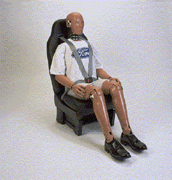TRW Displays Four-Point Safety Belt in Volvo Concept Car
 |
"We are pleased to be involved in this development project at the Ford exhibit area," said Jeff Aird, TRW director of customer development for Ford. "TRW is the world's leading producer of safety belt systems and a strong supporter of efforts to increase belt usage and vehicle safety."
Two four-point belt configurations are being shown. They are based on the three-point belts that are prevalent today, of which TRW makes more than 58 million per year. Volvo holds the original patent for the three-point belt system, which extends diagonally from one shoulder, across the body and is buckled along with a lap belt.
One version of the four-point belt is an X-shape that includes a second belt that extends diagonally from the other shoulder and across to another buckle at the base of the seat. A second version uses two shoulder/lap belt assemblies that are fastened in a V-shape to a centrally located buckle. Both of the four-point restraint concepts from the consumer clinic are included in the Volvo concept vehicle.
TRW has provided four-point racing safety belt harnesses since 1974 to the European automobile racing series through its TRW Sabelt subsidiary in Italy. In 2000, TRW Sabelt also fitted its racing harness in the Ferrari Formula 1 World Champion.
"The safety belt, in any form, is the single most effective device to protect a vehicle occupant in a crash and to reduce their risk of injury," said Paul Bedewi, a technical specialist in Ford's safety research and development area. "Ford is attempting to enhance safety, convenience and comfort even further by seeking consumer input into developing belts that people prefer and plan to use."
Arnie Herberg, an engineer in research and development at TRW Occupant Safety Systems, said the consumer input "will be extremely valuable in working with Ford and Volvo on future safety belt developments." Herberg said the four-point belt has the potential to improve load distribution at the shoulder and chest, as well as improving system comfort and ergonomics for children and older occupants.
The systems can also accommodate pretensioners and energy management devices, he added. Furthermore, the systems are able to address the image and performance targets of sports car and off-road vehicle applications.
&


